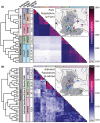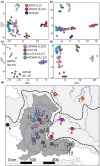Genomic divergence, local adaptation, and complex demographic history may inform management of a popular sportfish species complex
- PMID: 36225830
- PMCID: PMC9534746
- DOI: 10.1002/ece3.9370
Genomic divergence, local adaptation, and complex demographic history may inform management of a popular sportfish species complex
Abstract
The Neosho Bass (Micropterus velox), a former subspecies of the keystone top-predator and globally popular Smallmouth Bass (M. dolomieu), is endemic and narrowly restricted to small, clear streams of the Arkansas River Basin in the Central Interior Highlands (CIH) ecoregion, USA. Previous studies have detected some morphological, genetic, and genomic differentiation between the Neosho and Smallmouth Basses; however, the extent of neutral and adaptive divergence and patterns of intraspecific diversity are poorly understood. Furthermore, lineage diversification has likely been impacted by gene flow in some Neosho populations, which may be due to a combination of natural biogeographic processes and anthropogenic introductions. We assessed: (1) lineage divergence, (2) local directional selection (adaptive divergence), and (3) demographic history among Smallmouth Bass populations in the CIH using population genomic analyses of 50,828 single-nucleotide polymorphisms (SNPs) obtained through ddRAD-seq. Neosho and Smallmouth Bass formed monophyletic clades with 100% bootstrap support. We identified two major lineages within each species. We discovered six Neosho Bass populations (two nonadmixed and four admixed) and three nonadmixed Smallmouth Bass populations. We detected 29 SNPs putatively under directional selection in the Neosho range, suggesting populations may be locally adapted. Two populations were admixed via recent asymmetric secondary contact, perhaps after anthropogenic introduction. Two other populations were likely admixed via combinations of ancient and recent processes. These species comprise independently evolving lineages, some having experienced historical and natural admixture. These results may be critical for management of Neosho Bass as a distinct species and may aid in the conservation of other species with complex biogeographic histories.
Keywords: conservation; demography; divergence; diversity; gene flow; local adaptation.
© 2022 The Authors. Ecology and Evolution published by John Wiley & Sons Ltd.
Conflict of interest statement
The authors declare that they have no conflict of interest.
Figures





Similar articles
-
Movement and habitat use by smallmouth bass Micropterus dolomieu velox in a dynamic Ozark Highlands riverscape.J Fish Biol. 2022 Jul;101(1):100-114. doi: 10.1111/jfb.15076. Epub 2022 May 31. J Fish Biol. 2022. PMID: 35511418
-
Phenotypic homogenization and potential fitness constraints following non-native introgression in an endemic sportfish.J Evol Biol. 2025 Jan 3;38(1):94-110. doi: 10.1093/jeb/voae137. J Evol Biol. 2025. PMID: 39485793
-
Phylogenomics and species delimitation of the economically important Black Basses (Micropterus).Sci Rep. 2022 Jun 6;12(1):9113. doi: 10.1038/s41598-022-11743-2. Sci Rep. 2022. PMID: 35668124 Free PMC article.
-
Forecasting effects of angler harvest and climate change on smallmouth bass abundance at the southern edge of their range.PLoS One. 2018 Aug 20;13(8):e0202737. doi: 10.1371/journal.pone.0202737. eCollection 2018. PLoS One. 2018. PMID: 30125314 Free PMC article.
-
Utilization of protein expression profiles as indicators of environmental impairment of smallmouth bass (Micropterus dolomieu) from the Shenandoah River, Virginia, USA.Environ Toxicol Chem. 2008 Aug;27(8):1756-67. doi: 10.1897/07-588. Epub 2008 Mar 3. Environ Toxicol Chem. 2008. PMID: 18315392
Cited by
-
Impoundments facilitate upstream invasion and introgression: Case studies of fluvial black basses (Micropterus spp.) in the southeastern USA.PLoS One. 2025 Feb 5;20(2):e0315620. doi: 10.1371/journal.pone.0315620. eCollection 2025. PLoS One. 2025. PMID: 39908247 Free PMC article.
References
-
- Altukhov, Y. P. , & Salmenkova, E. A. (1987). Stock transfer relative to natural organization, management, and conservation of fish populations. In Ryman N. & Utter F. (Eds.), Population Genetics and Fishery Management (pp. 333–344). Seattle.
LinkOut - more resources
Full Text Sources

